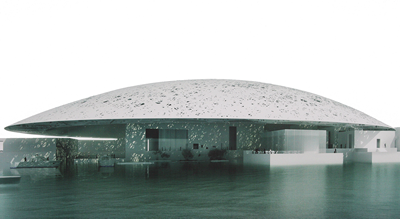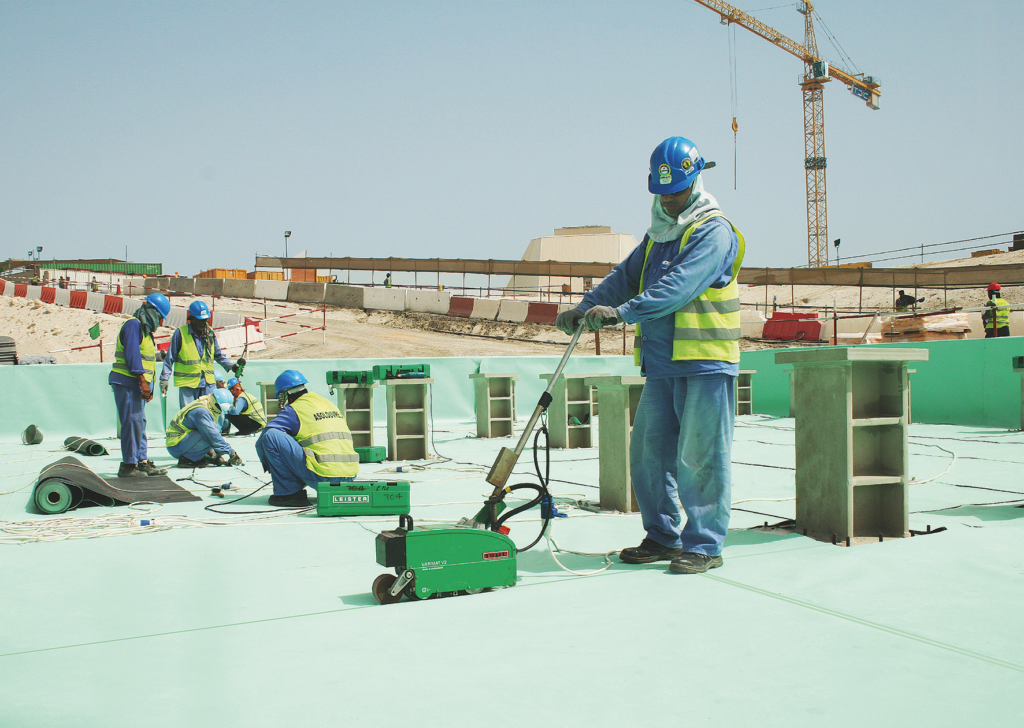
By Christophe von Arx — The island of Saadiyat off the coast of Abu Dhabi in the United Arab Emirates is expanding to become a cultural center for locals and tourists. Construction on the “Louvre Abu Dhabi”, the first of several museums, will be completed by 2015. The ambitious project from the French star architect Jean Nouvel will have a large white dome with a diameter of 180 meters that covers the building like a canopy of foliage.
Since the entire complex will be in the water, the sealing system in the subsoil will be of significant importance.
Two Layers of Geomembrane Protection
The Abu Dhabi Louvre will be surrounded by water. The grounds will not be flooded until after the completion of the construction. Protecting the concrete foundation is the highest priority.

To ensure water-tightness, a two-layered system was selected. A 1.6 mm thick, TPO Sikaplan membrane was specified for the lower geomembrane. The 2m wide geomembrane was connected with the TWINNY S welder from Leister. This machine welds a double seam with its special nozzle. This way, after the welding process, the water-tightness can be tested in the groove created between the seams using a testing needle and compressed air.
For the waterproofing systems upper geomembrane layer, another Sikaplan geomembrane (2.5 mm TPO) was selected. As with the lower layer, it is first connected track-by-track and then welded to the lower layer at the edges sector by sector. The installation crew used a VARIMAT V2 for this layer, capitalizing on the hot air welder’s peak speed of up to 12 m/min. The equipment also allowed the team to control and save relevant welding parameters with an “e-Drive” control unit.
Following installation of both geomembrane layers, the air between them was removed, creating a vaccum.
Subsequent installation of monitoring sensors will provide long-term monitoring of air-tightness.
Waterstops for Additional Safety

Waterstops were added to the installed geomembrane layers as a third safety measure. The waterstops were welded to the geomembranes in defined sectors and prevent additional dispersion of water, in the event of leakage.
An advantage of waterstops is that as more of them are added, the potential surface area that might need repairs due to leakage decreases.
A TRIACE DRIVE AT from Leister was used to process the waterstops. The equipment is a semi-automatic welder with hard steel rollers, making it ideal for waterstop applications. The equipment allows enough pressure to weld the relatively rigid tapes to the geomembranes below.
Prepartion Is Key
These three measures—connecting the geomembranes with a double welding seam, vacuum between the two system layers, and the use of waterstops—have achieved absolute water-tightness for the new Louvre.
The preparation of the seams was vital. Clean seams ensure the possibility of perfectly welded seams. In Abu Dhabi, where wind-blown dust is a common site challenge, it was especially important to clean seams thoroughly before welding.
Also, the installer team utilized power sources that were not connected to the grid. This precaution protected the seaming operation from potential instability and fluctuations in the power grid’s supply.
Details by Hand

The cement beams that jut from the foundation were encased with 1.6 mm and 2.5 mm Sikaplan TPO and connected with the sealing system. The installation crews used a TRIAC AT hot air hand tool, which is well suited to outdoor work, for this task and many other detail points. The equipment enabled set temperatures to be achieved automatically and built-in voltage fluctuation controls sustained the quality. A thermal probe installed upstream from the heating element guaranteed precise, constant temperatures.
Achieving an Ambitious Mission
In total, the installation team processed 250,000 m2 of geomembranes. That work involved more than 150,000 m of welded seams (!).
There’s no question: In such a large project, the installation crew must be able to trust to the reliability of the welding machines, especially in such harsh outdoor conditions.
DETAILS FROM ABU DHABI
Equipment manufacturer: Leister Technologies AG, Switzerland, www.leister.com
Sealing system supplier: Sika, Switzerland, www.sika.com
Leister Sales and Service Center: BMC Gulf Trading LLC, Dubai, www.bmc-plasticwelding.com
A PDF copy of this story is available here.











